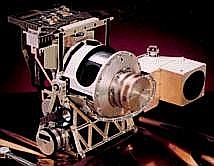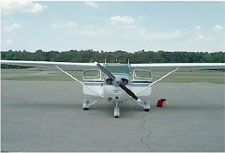Welcome to Chesapeake Bay Remote Sensing Program (CBRSP)
 Chesapeake Bay Remote Sensing Program (CBRSP) recently completed the 25th year of airborne remote sensing of ocean color on Chesapeake Bay. We conducted 23 flights with the SeaWiFS Aircraft Simulator from March through September 2013 and have posted the imagery on this website. The data for 2013 revealed a well-developed spring bloom covering the mid to lower Bay when chlorophyll (chl-a) reached concentrations of 15-20 mg m-3 in April and May. A commonly observed decline of chl-a occurred in summer with chl-a < 10 mg m-3 from June through September. We thank many people who have made this program possible, including students, technicians, pilots, operators, and colleagues in academics, industry and various agencies. It is an arduous task to keep a program going for so many years, and we gratefully acknowledge the generous support of NSF, NASA, NOAA, EPA, and Maryland Sea Grant.
Chesapeake Bay Remote Sensing Program (CBRSP) recently completed the 25th year of airborne remote sensing of ocean color on Chesapeake Bay. We conducted 23 flights with the SeaWiFS Aircraft Simulator from March through September 2013 and have posted the imagery on this website. The data for 2013 revealed a well-developed spring bloom covering the mid to lower Bay when chlorophyll (chl-a) reached concentrations of 15-20 mg m-3 in April and May. A commonly observed decline of chl-a occurred in summer with chl-a < 10 mg m-3 from June through September. We thank many people who have made this program possible, including students, technicians, pilots, operators, and colleagues in academics, industry and various agencies. It is an arduous task to keep a program going for so many years, and we gratefully acknowledge the generous support of NSF, NASA, NOAA, EPA, and Maryland Sea Grant.
The Chesapeake Bay Remote Sensing Program (CBRSP) has produced a long-term set of ‘ocean color’ measurements from  measurements from light aircraft to estimate chlorophyll (chl-a) concentrations in Chesapeake Bay, covering the 25-year period from 1989 through 2013. Chl-a is a photosynthetic pigment common to all microscopic algae - phytoplankton - the main primary producers that comprise the base of the food web in the Bay. This important pigment imparts color to the water that can be detected using advanced radiometers. Clear blue water has low chl-a and strongly reflects light at wavelengths at the low end of the visible spectrum, whereas green water has higher chl-a and absorbs strongly in the blue, reflecting light at longer wavelengths. We collect data using airborne radiometric instruments that allow us to measure the reflected light and ascertain concentrations of chl-a. This single property is a key ingredient we need to estimate primary productivity and to gauge the overall productivity of the ecosystem at higher trophic levels..
measurements from light aircraft to estimate chlorophyll (chl-a) concentrations in Chesapeake Bay, covering the 25-year period from 1989 through 2013. Chl-a is a photosynthetic pigment common to all microscopic algae - phytoplankton - the main primary producers that comprise the base of the food web in the Bay. This important pigment imparts color to the water that can be detected using advanced radiometers. Clear blue water has low chl-a and strongly reflects light at wavelengths at the low end of the visible spectrum, whereas green water has higher chl-a and absorbs strongly in the blue, reflecting light at longer wavelengths. We collect data using airborne radiometric instruments that allow us to measure the reflected light and ascertain concentrations of chl-a. This single property is a key ingredient we need to estimate primary productivity and to gauge the overall productivity of the ecosystem at higher trophic levels..
Advantages of ocean color measurements using remote sensing to determine chlorophyll
The advantages of using remote sensing to measure ocean color are rapid coverage of the Bay made possible by aircraft, and the high spatial and temporal resolution of chl-a that can be obtained. CBRSP has made > 450 flights from 1989 to 2013 in a program supported by multiple sponsors over the years, including Maryland Sea Grant, NOAA, NASA, EPA, and NSF. Flights are conducted at a frequency of up to twice per week on the main stem of the Bay, and we have made monthly flights on several in conjunction with specific projects. CBRSP uses ocean-color sensors similar to the Sea-viewing Wide Field-of-view Sensor (SeaWiFS) instrument in earth orbit that has provided global coverage of ocean color. Flight tracks that cover the study sites are flown at an altitude of 500 feet (150 meters), requiring ca. 4-5 h for the main Bay.
rapid coverage of the Bay made possible by aircraft, and the high spatial and temporal resolution of chl-a that can be obtained. CBRSP has made > 450 flights from 1989 to 2013 in a program supported by multiple sponsors over the years, including Maryland Sea Grant, NOAA, NASA, EPA, and NSF. Flights are conducted at a frequency of up to twice per week on the main stem of the Bay, and we have made monthly flights on several in conjunction with specific projects. CBRSP uses ocean-color sensors similar to the Sea-viewing Wide Field-of-view Sensor (SeaWiFS) instrument in earth orbit that has provided global coverage of ocean color. Flight tracks that cover the study sites are flown at an altitude of 500 feet (150 meters), requiring ca. 4-5 h for the main Bay.
History / background of data and information from the surveys
Our initial Bay flights (1989-1995) to measure ocean color used the Ocean Data Acquisition System (ODAS), a relatively simple instrument that was developed in the mid-1980s at NASA Goddard Space Flight Center. ODAS consisted of three radiometers in the blue-green region of the visible spectrum that measured water-leaving radiances at 460, 490 and 520 nm. We augmented ODAS in 1995-96 data with the SeaWiFS Aircraft Simulator (SAS II) from Satlantic, Inc. (Halifax, Nova Scotia) that replaced the ODAS instrument. SAS II contained sensors at seven  wavebands, including the six visible bands of the SeaWiFS satellite ocean color instrument. The additional bands of SAS II allowed improved recoveries of chl-a in highly turbid conditions and at the extremely high concentrations that accompany red tides. An improved version of the SeaWiFS Aircraft Simulator (SAS III) went into service in 1997 and we have used this instrument in Bay and tributary flights for ~16 years. SAS III is a 13-band instrument with improved spectral resolution. All the instruments (ODAS, SAS II, SAS III) are paired with an infrared temperature sensor that we use to measure sea surface temperature during flights. One of our principal sponsors during the lifetime of CBRSP, the NOAA Chesapeake Bay Office, has distributed imagery derived from the flights in a productive collaboration.
wavebands, including the six visible bands of the SeaWiFS satellite ocean color instrument. The additional bands of SAS II allowed improved recoveries of chl-a in highly turbid conditions and at the extremely high concentrations that accompany red tides. An improved version of the SeaWiFS Aircraft Simulator (SAS III) went into service in 1997 and we have used this instrument in Bay and tributary flights for ~16 years. SAS III is a 13-band instrument with improved spectral resolution. All the instruments (ODAS, SAS II, SAS III) are paired with an infrared temperature sensor that we use to measure sea surface temperature during flights. One of our principal sponsors during the lifetime of CBRSP, the NOAA Chesapeake Bay Office, has distributed imagery derived from the flights in a productive collaboration.
Tributary flights in CISNet and ACE INC
In addition to the weekly surveys of main stem of the Bay, CBRSP conducted monthly tributary surveys of the Choptank and Patuxent Rivers for several years. The Choptank and Patuxent River flights were part of the EPA Coastal Intensive Site Network (CISNet). Our goal was to measure chl-a in two systems with strongly contrasting watersheds, agriculture in the case of the Choptank, suburban in the case of the Patuxent. Several other tributaries were added to the Choptank and Patuxent R., including the James R., Rappahannock R., and Potomac R. that drain into Chesapeake Bay, and Albemarle-Pamlico Sound in North Carolina, as part of an EPA / NASA project, Atlantic Consortium of Environmental Indicators (ACE INC).
Current flights
We will be continuing main stem flights in 2013 as part of a project funded by NSF Biological and Physical Oceanography Programs. This project combines observations and modeling to separate the influence of climatic perturbations (tropical storms, drought/flood cycle) from long-term changes in chl-a accompanying over-enrichment of the Bay. Comparative studies are being undertaken in Albemarle-Pamlico Sounds, including targeted, event-based overflights and a number of in-situ sampling approaches.